Path Loss and Auxiliary Communication Analysis of VANET in Tunnel Environments
Abstract
1. Introduction
- (1)
- We propose a new path loss calculation scheme that can be used for information transmission between vehicles in tunnels. In the proposed scheme, not only the factors of the road and tunnel wall are considered, but also the differences in reflection coefficient between the road materials and tunnel wall fireproof coatings, which can better improve the accuracy of vehicle information transmission.
- (2)
- We propose a solution based on a reinforcement learning algorithm to improve the efficiency of vehicle RSU collaboration, to solve the problem of poor communication performance between vehicles in tunnels and improve the information transmission efficiency. By utilizing V-MIMO technology, vehicles can share their own data with each other, and vehicles and RSUs can also collaborate to transmit data.
2. System Model
2.1. Analysis of Path Loss in a Tunnel
2.1.1. Path Length
- (1)
- One-time reflection path
- (2)
- Two-time reflection path
- (3)
- Three-time reflections path
- (4)
- n-time refelection path
2.1.2. Path Loss Calculation
2.2. V-MIMO Model in a Tunnel
2.2.1. The Probability of Successful V2R (Vehicle-to-RSU) Transmission in a Tunnel
2.2.2. Analysis of V-MIMO Transmission in Tunnels
- (1)
- V-MIMO Case
- (2)
- V-SIMO Case
- (3)
- V-MISO Case
- (4)
- V-SISO Case
2.3. Application of Deep Reinforcement Learning Models in Tunnels
| Algorithm 1 Optimal channel matching algorithm based on V-DQN |
|
3. Performance Evaluation
3.1. The Relationship between the Path Loss and the Reflection Times
3.2. Analysis of V2V Path Loss under Different Reflections
3.3. Analysis of V-MIMO Channel Capacity Simulation in a Tunnel
3.4. Analysis of Deep Reinforcement Learning
4. Conclusions
Author Contributions
Funding
Data Availability Statement
Conflicts of Interest
References
- Boban, M.; Kousaridas, A.; Manolakis, K.; Eichinger, J.; Xu, W. Connected Roads of the Future: Use Cases, Requirements, and Design Considerations for Vehicle-to-Everything Communications. IEEE Veh. Technol. Mag. 2018, 13, 110–123. [Google Scholar] [CrossRef]
- Ferreira, M.; Damas, L.; Conceicão, H.; d’Orey, P.M.; Fernandes, R.; Steenkiste, P.; Gomes, P. Self-automated parking lots for autonomous vehicles based on vehicular ad hoc networking. In Proceedings of the 2014 IEEE Intelligent Vehicles Symposium, Dearborn, MI, USA, 8–11 June 2014; pp. 472–479. [Google Scholar] [CrossRef]
- 3GPP. Study on LTE Support for V2X Services (Release 14); Tech. Rep. 3GPP TR 22.885 V1.0.0; 3rd Generation Partnership Project: Sophia Antipolis, France, 2015. [Google Scholar]
- Fodor, G.; Do, H.; Ashraf, S.A.; Blasco, R.; Sun, W.; Belleschi, M.; Hu, L. Supporting Enhanced Vehicle-to-Everything Services by LTE Release 15 Systems. IEEE Commun. Stand. Mag. 2019, 3, 26–33. [Google Scholar] [CrossRef]
- Martinez, F.J.; Toh, C.; Cano, J.; Calafate, C.T.; Manzoni, P. Emergency Services in Future Intelligent Transportation Systems Based on Vehicular Communication Networks. IEEE Intell. Transp. Syst. Mag. 2010, 2, 6–20. [Google Scholar] [CrossRef]
- 3GPP. Study Enhancement of 3GPP Support for 5G V2X Services (Release 15); Tech. Rep. 3GPP TR 22.886 V1.0.0; 3rd Generation Partnership Project: Sophia Antipolis, France, 2016. [Google Scholar]
- Chen, S.; Hu, J.; Shi, Y.; Peng, Y.; Fang, J.; Zhao, R.; Zhao, L. Vehicle-to-Everything (v2x) Services Supported by LTE-Based Systems and 5G. IEEE Commun. Stand. Mag. 2017, 1, 70–76. [Google Scholar] [CrossRef]
- Kapoor, A.; Kumar, P.; Mishra, R. High Gain Modified Vivaldi Vehicular Antenna for IoV Communications in 5G Network. Heliyon 2022, 8, e09336. [Google Scholar] [CrossRef]
- Fernández, H.; Rubio, L.; Rodrigo-Peñarrocha, V.M.; Reig, J. Path Loss Characterization for Vehicular Communications at 700 MHz and 5.9 GHz Under LOS and NLOS Conditions. IEEE Antennas Wirel. Propag. Lett. 2014, 13, 931–934. [Google Scholar] [CrossRef]
- Hrovat, A.; Kandus, G.; Javornik, T. A Survey of Radio Propagation Modeling for Tunnels. IEEE Commun. Surv. Tutorials 2014, 16, 658–669. [Google Scholar] [CrossRef]
- Klozar, L.; Prokopec, J. Propagation path loss models for mobile communication. In Proceedings of the 21st International Conference Radioelektronika, Brno, Czech Republic, 19–20 April 2011; pp. 1–4. [Google Scholar] [CrossRef]
- Tian, J.; Meng, F. Comparison Survey of Mobility Models in Vehicular Ad-Hoc Network (VANET). In Proceedings of the 2020 IEEE 3rd International Conference on Automation, Electronics and Electrical Engineering (AUTEEE), Shenyang, China, 20–22 November 2020; pp. 337–342. [Google Scholar] [CrossRef]
- Li, H.; Zhou, Y.; Shen, B.; Ling, L.; Xia, J.; Yang, T.; Lu, Q.; Zhou, Y.; Liu, Y. Research on Tunnel Wireless Communication Technology. In Proceedings of the 2020 International Conference on Wireless Communications and Smart Grid (ICWCSG), Qingdao, China, 12–14 June 2020; pp. 72–75. [Google Scholar] [CrossRef]
- Shakhobiddinov, A.; Shamsiev, A.; Narzullaev, I.; Shoniyozov, G. About Organization of Mobile Communications in Long Car Tunnels. In Proceedings of the 2019 International Conference on Information Science and Communications Technologies (ICISCT), Tashkent, Uzbekistan, 4–6 November 2019; pp. 1–3. [Google Scholar] [CrossRef]
- Rashdi, M.A.; Nadir, Z.; Al-Lawati, H. Applicability of Okumura–Hata Model for Wireless Communication Systems in Oman. In Proceedings of the 2020 IEEE International IOT, Electronics and Mechatronics Conference (IEMTRONICS), Vancouver, BC, Canada, 9–12 September 2020; pp. 1–6. [Google Scholar] [CrossRef]
- Akhpashev, R.V.; Andreev, A.V. COST 231 Hata adaptation model for urban conditions in LTE networks. In Proceedings of the 2016 17th International Conference of Young Specialists on Micro/Nanotechnologies and Electron Devices (EDM), Erlagol, Russia, 30 June–4 July 2016; pp. 64–66. [Google Scholar] [CrossRef]
- Galvan-Tejada, G.M. WiMAX urban coverage based on the Lee model and the Deygout diffraction method. In Proceedings of the 2010 7th International Conference on Electrical Engineering Computing Science and Automatic Control, Tuxtla Gutierrez, Mexico, 8–10 September 2010; pp. 294–299. [Google Scholar] [CrossRef]
- Wang, W.; Zhang, Y.; Yao, W.; Wang, S. The propagation model of RFID systems in ETC. In Proceedings of the 2009 IEEE International Conference on Communications Technology and Applications, Beijing, China, 16–18 October 2009; pp. 54–57. [Google Scholar] [CrossRef]
- Onipe, J.A.; Alenoghena, C.O.; Salawu, N.; Numan, P.E. Optimal Propagation Models for Path-loss Prediction in a Mountainous Environment at 2100MHz. In Proceedings of the 2020 International Conference in Mathematics, Computer Engineering and Computer Science (ICMCECS), Ayobo, Nigeria, 18–21 March 2020; pp. 1–6. [Google Scholar] [CrossRef]
- Prior, P.; Cota, N. Railways Communications Propagation Prediction over Irregular Terrain using Longley-Rice Model. In Proceedings of the 2021 28th International Conference on Telecommunications (ICT), London, UK, 1–3 June 2021; pp. 1–5. [Google Scholar] [CrossRef]
- Abdulrasheed, I.Y.; Faruk, N.; Surajudeen-Bakinde, N.T.; Olawoyin, L.A.; Oloyede, A.A.; Popoola, S.I. Kriging based model for path loss prediction in the VHF band. In Proceedings of the 2017 IEEE 3rd International Conference on Electro-Technology for National Development (NIGERCON), Owerri, Nigeria, 7–10 November 2017; pp. 173–176. [Google Scholar] [CrossRef]
- Zhi, F. “Soft Ribs” of Tunnel Asphalt Pavement. China Highw. 2006, 22, 88–89. (In Chinese) [Google Scholar]
- Wang, S.; Lin, Z.; Yu, S. The characteristic and damage of fire accidents in road tunnel. Fire Sci. Technol. 2011, 30, 337–340. (In Chinese) [Google Scholar]
- Zhou, M. On features and hazards of fire accidents in road tunnels. Shanxi Archit. 2013, 39, 156–157. (In Chinese) [Google Scholar]
- Yao, Y.D.; Yin, G.F.; Cheng, X.W.; Gou, X.L. Design and Properties of Fire-Proof Coating for Tunnels. Key Eng. Mater. 2007, 40, 1753–1755. [Google Scholar] [CrossRef]
- Hanzo, L.; El-Hajjar, M.; Alamri, O. Near-Capacity Wireless Transceivers and Cooperative Communications in the MIMO Era: Evolution of Standards, Waveform Design, and Future Perspectives. Proc. IEEE 2011, 99, 1343–1385. [Google Scholar] [CrossRef]
- Alamouti, S.M. A simple transmit diversity technique for wireless communications. IEEE J. Sel. Areas Commun. 1998, 16, 1451–1458. [Google Scholar] [CrossRef]
- Jiang, J.; Dianati, M.; Imran, M.A.; Tafazolli, R.; Zhang, S. Energy-Efficiency Analysis and Optimization for Virtual-MIMO Systems. IEEE Trans. Veh. Technol. 2014, 63, 2272–2283. [Google Scholar] [CrossRef]
- Watanabe, I.; Nishimori, K.; Taniguchi, R.; Murakami, T. Effectiveness of the virtual massive MIMO in 5G with OFDM. In Proceedings of the International Symposium on Antennas and Propagation (ISAP), Osaka, Japan, 25–28 January 2021; pp. 211–212. [Google Scholar]
- Gong, Y.; Wang, X. Channel Capacity Analysis and Simulations of Distributed MIMO System. In Proceedings of the 2009 5th International Conference on Wireless Communications, Networking and Mobile Computing, Beijing, China, 24–26 September 2009; pp. 1–4. [Google Scholar] [CrossRef]
- Khurana, M.; Krishna, C.R. MIMO-based spatial diversity scheme in VANET scenario. In Proceedings of the 2015 1st International Conference on Next Generation Computing Technologies (NGCT), Dehradun, India, 4–5 September 2015; pp. 257–261. [Google Scholar] [CrossRef]
- Foerster, J.; Nardelli, N.; Farquhar, G.; Afouras, T.; Torr, P.H.S.; Kohli, P.; Whiteson, S. Stabilising experience replay for deep multi-agent reinforcement learning. In Proceedings of the 34th International Conference on Machine Learning, Sydney, Australia, 6–11 August 2017; Volume 70, pp. 1146–1155. [Google Scholar]
- Mnih, V.; Kavukcuoglu, K.; Silver, D.; Graves, A.; Antonoglou, I.; Wierstra, D.; Riedmiller, M. Playing Atari with Deep Reinforcement Learning. arXiv 2013, arXiv:1312.5602. [Google Scholar]
- Mnih, V.; Kavukcuoglu, K.; Silver, D.; Rusu, A.A.; Veness, J.; Bellemare, M.; Graves, A.; Riedmiller, M.; Fidjeland, A.K.; Ostrovski1, G.; et al. Human-level control through deep reinforcement learning. Nature 2015, 518, 529–533. [Google Scholar] [CrossRef] [PubMed]
- Li, C.; Zhang, D.H.Z.; Chen, W.; Du, Y.; Hu, X. A Path Loss Calculation Scheme for Highway ETC Charging Signal Propagation. Wseas Trans. Signal Process. 2014, 10, 301–308. [Google Scholar]
- ITU-R P.1238-7; Propagation Data and Prediction Methods for the Planning of Indoor Radio Communication Systems and Radio Local Area Networks in the Frequency Range 900 MHz to 100 GHz. International Telecommunication Union: Geneva, Switzerland, 2012; pp. 1–26.
- Mozaffari, M.; Saad, W.; Bennis, M.; Debbah, M. Unmanned Aerial Vehicle With Underlaid Device-to-Device Communications: Performance and Tradeoffs. IEEE Trans. Wirel. Commun. 2016, 15, 3949–3963. [Google Scholar] [CrossRef]
- He, Z.; Zhang, B.; Wang, J.; Wang, L.; Ren, Y.; Han, Z. Performance Analysis and Optimization for V2V-assisted UAV Communications in Vehicular Networks. In Proceedings of the IEEE International Conference on Communications (ICC), Dublin, Ireland, 7–11 June 2020; pp. 1–6. [Google Scholar] [CrossRef]
- Yang, H.; He, Y. Correlated Channel Capacity of Virtual MIMO Based on Distributed Satellites. Comput. Sci. 2015, 42, 276–278. (In Chinese) [Google Scholar]
- Jiang, L.; Huang, H.; Ding, Z. Path planning for intelligent robots based on deep Q-learning with experience replay and heuristic knowledge. IEEE/CAA J. Autom. Sin. 2020, 7, 1179–1189. [Google Scholar] [CrossRef]
- Ye, H.; Li, G.Y.; Juang, B.F. Deep Reinforcement Learning Based Resource Allocation for V2V Communications. IEEE Trans. Veh. Technol. 2019, 68, 3163–3173. [Google Scholar] [CrossRef]
- Xiao, Y.; Du, Z.; Feng, C.; Wang, M. Study on Reflection Coefficient of Tunnel Ceiling Materials to the Road Average Luminance. J. Wuhan Univ. Technol. (Transp. Sci. Eng.) 2015, 39, 363–366. (In Chinese) [Google Scholar]
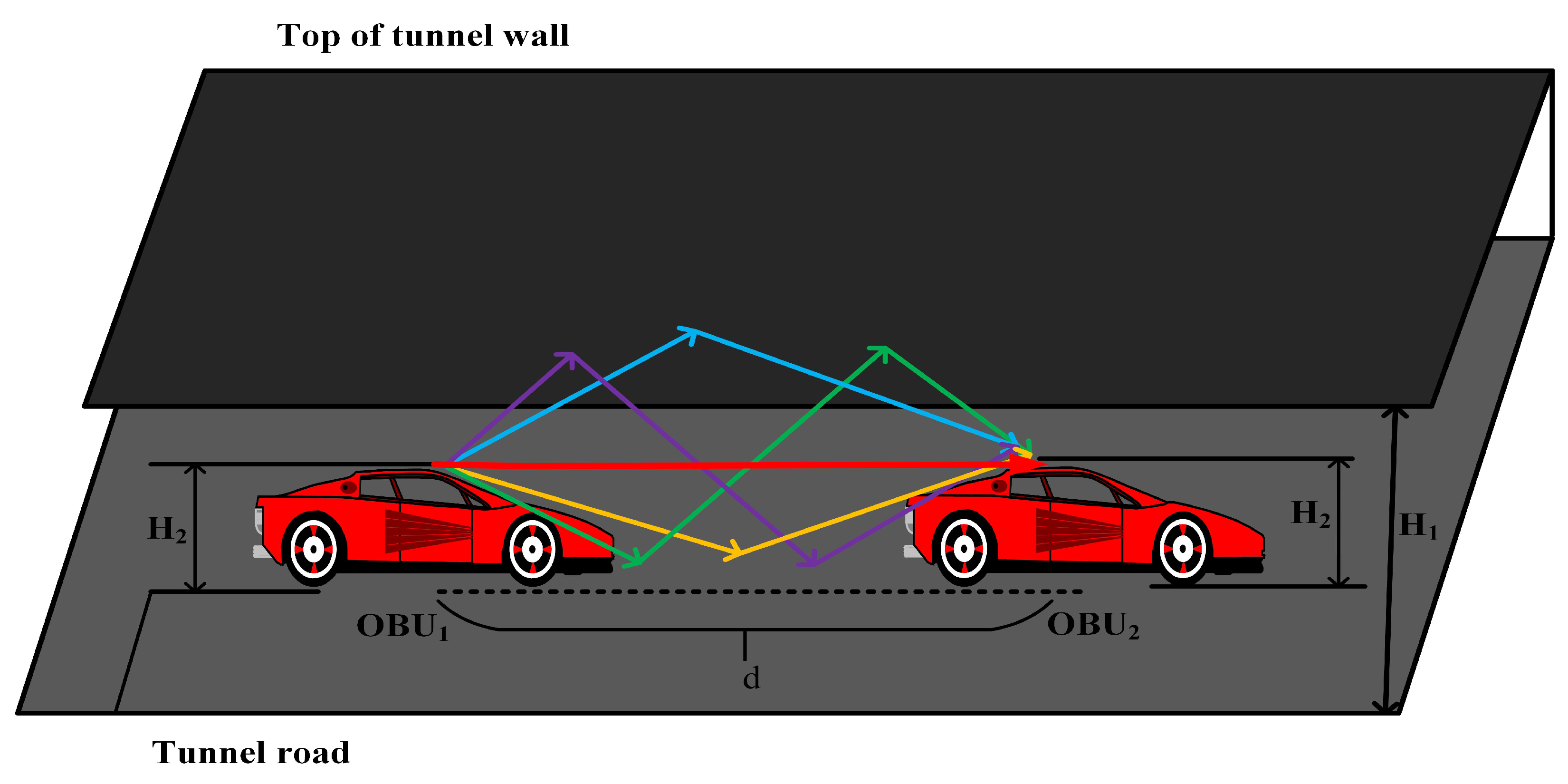
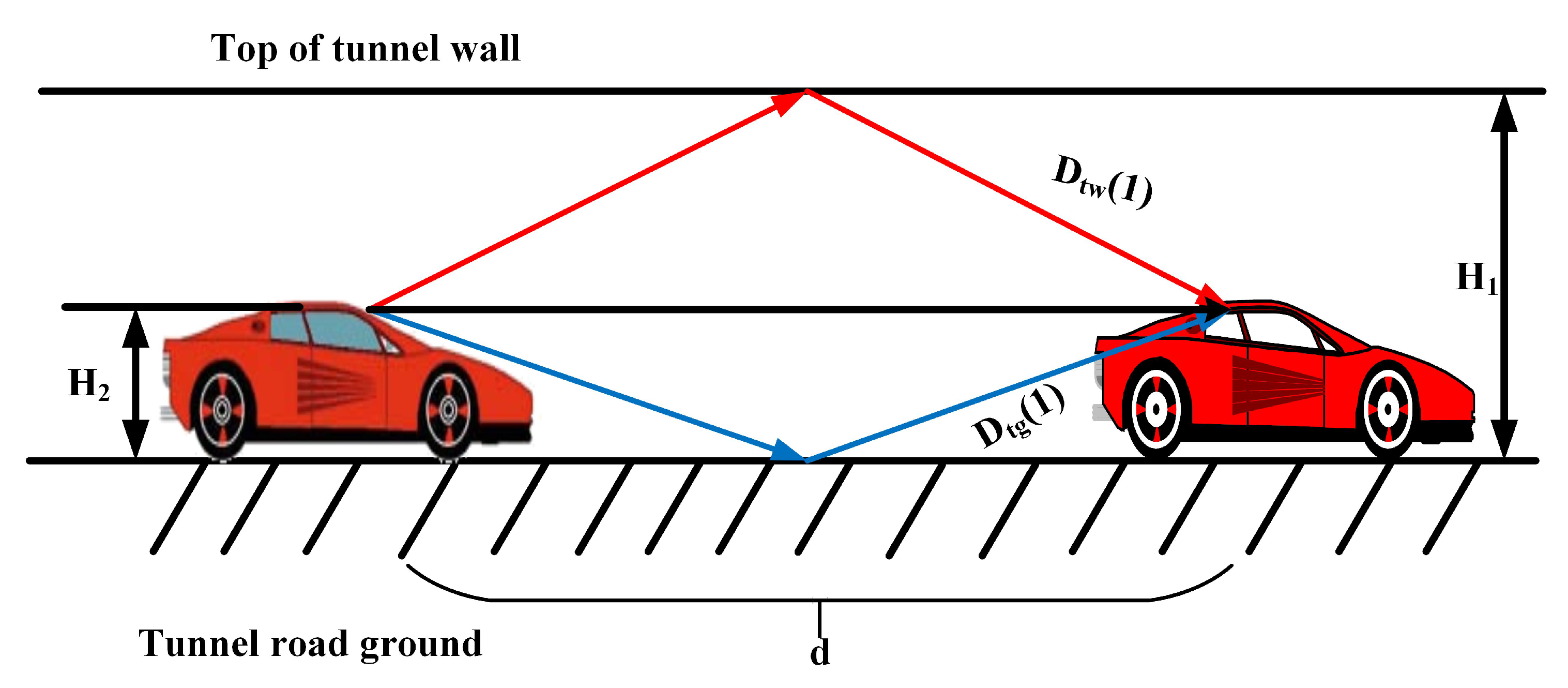
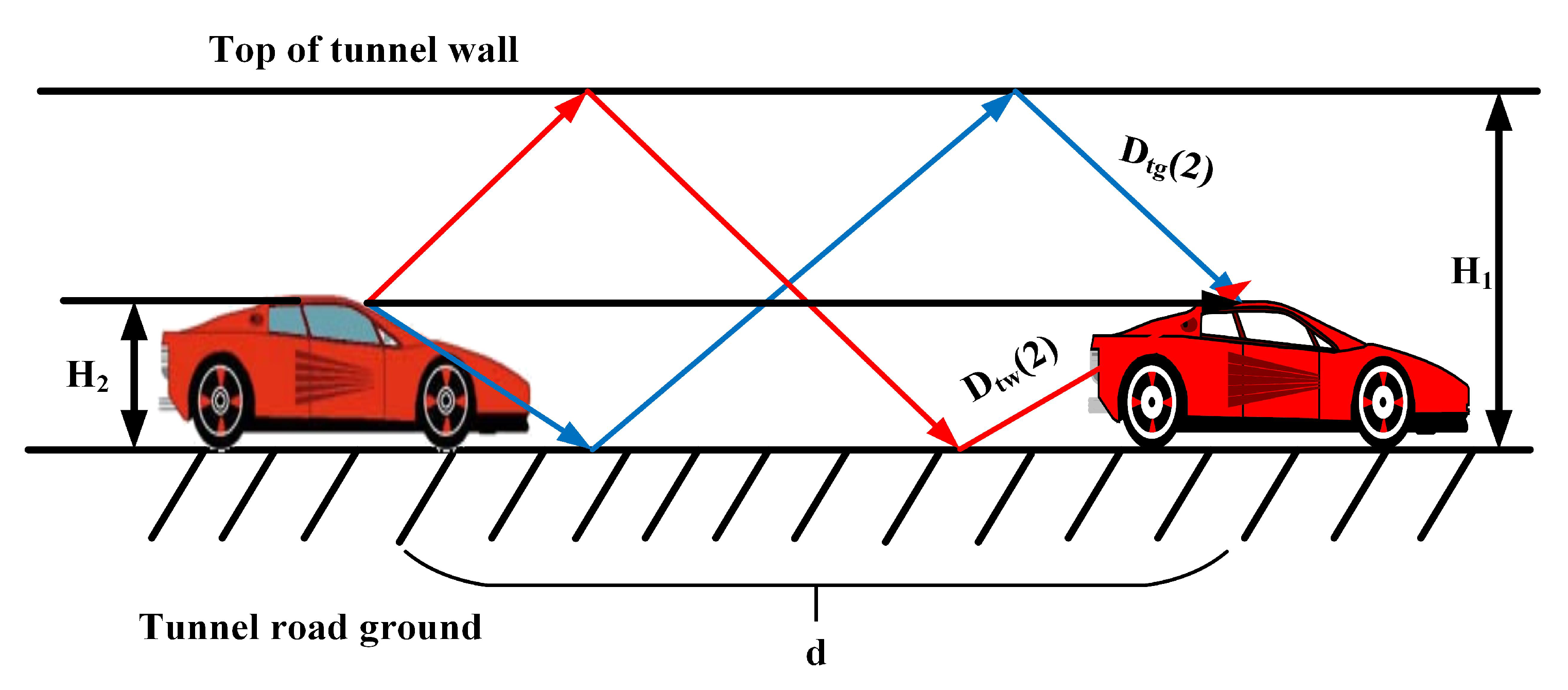
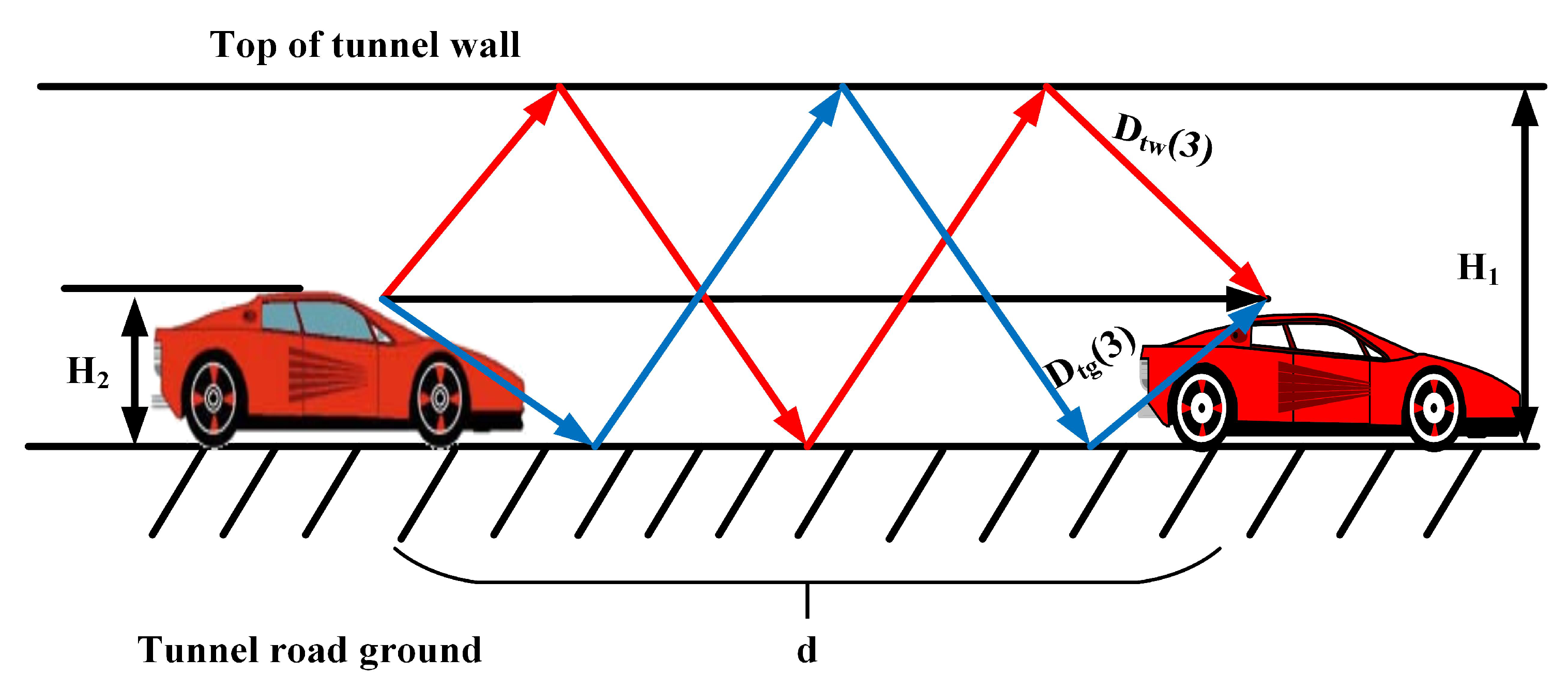
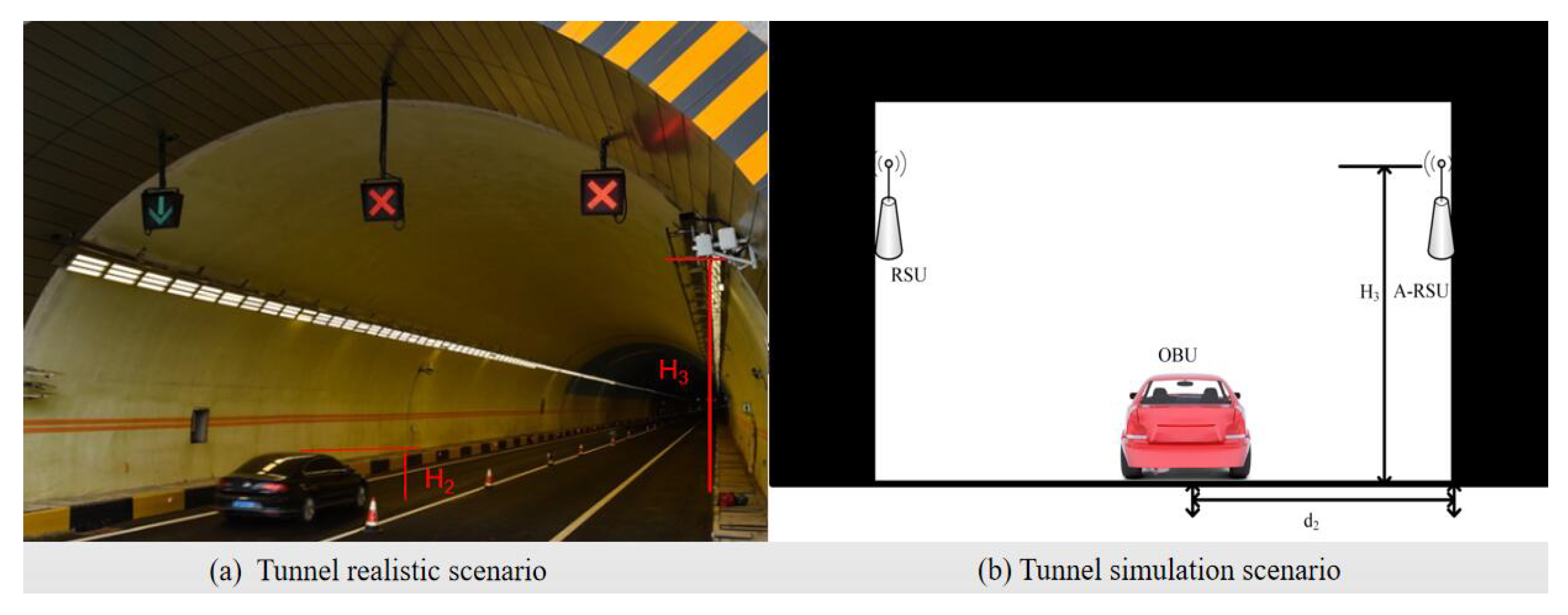
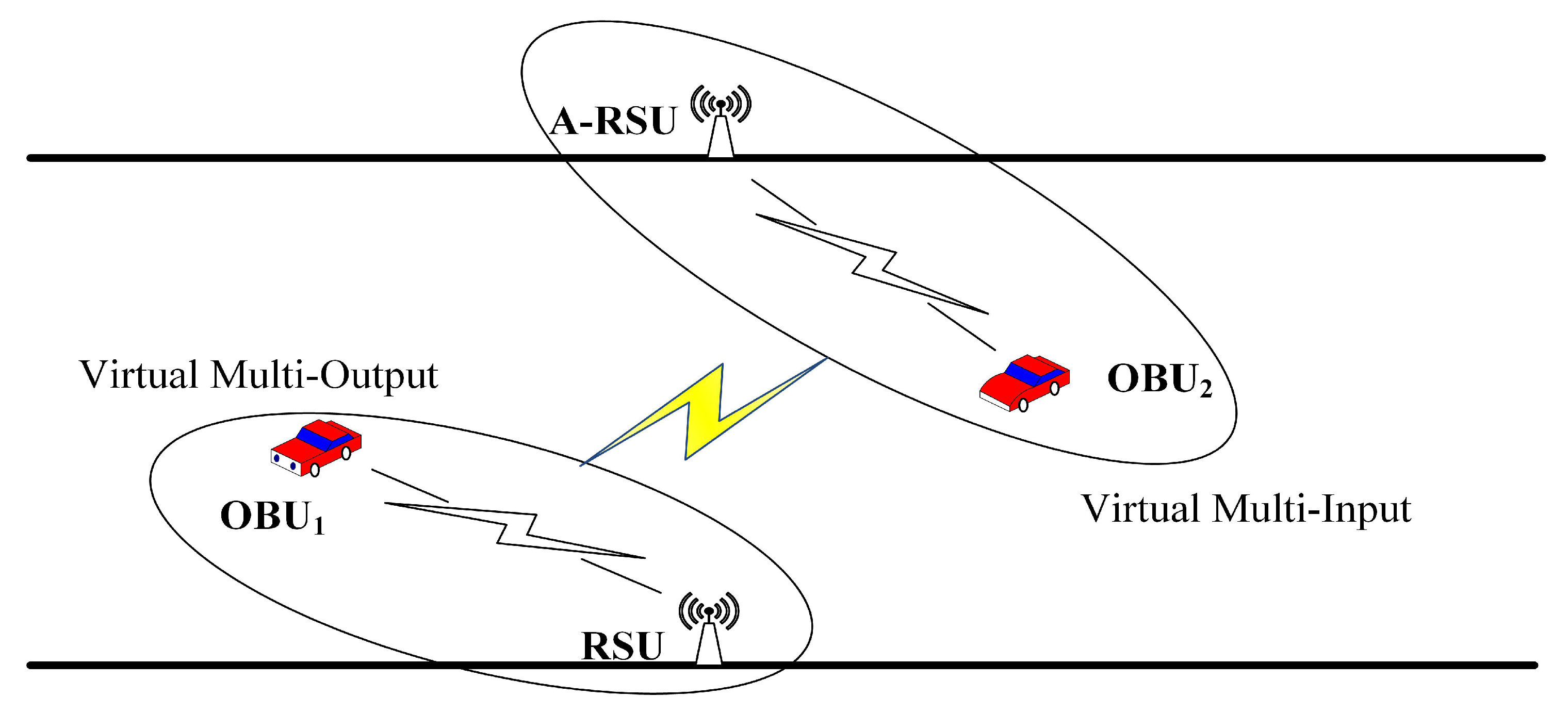
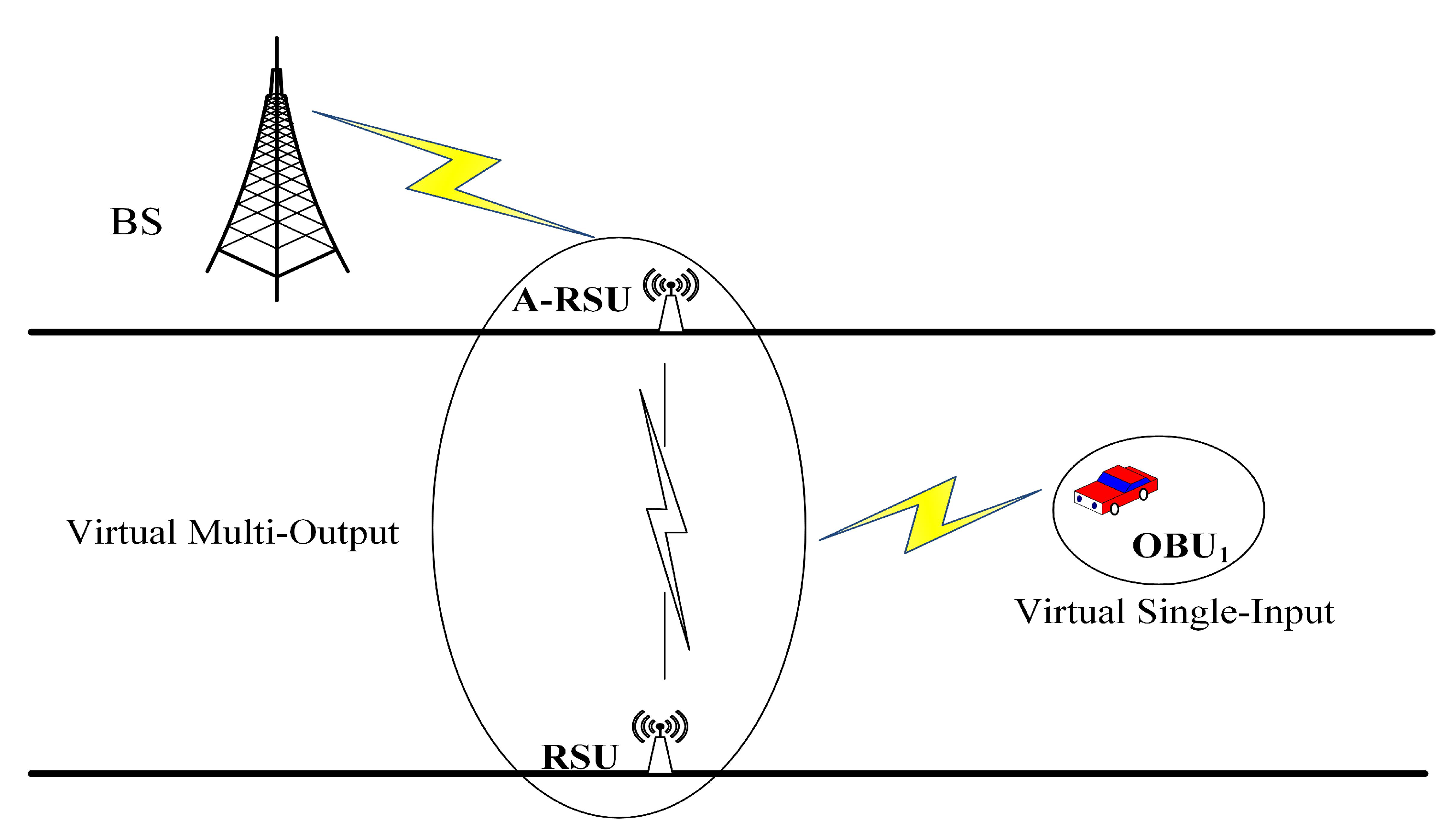
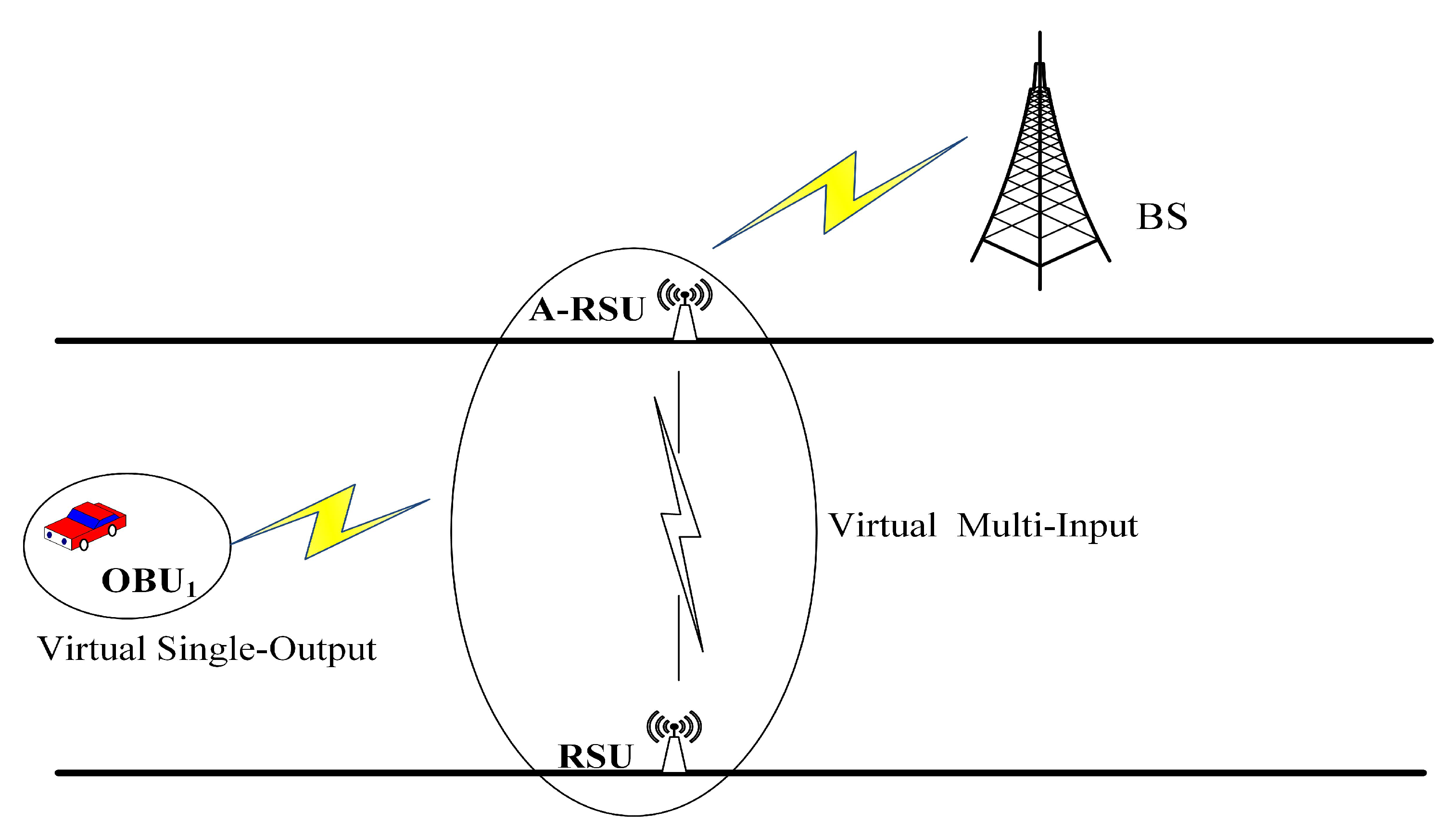

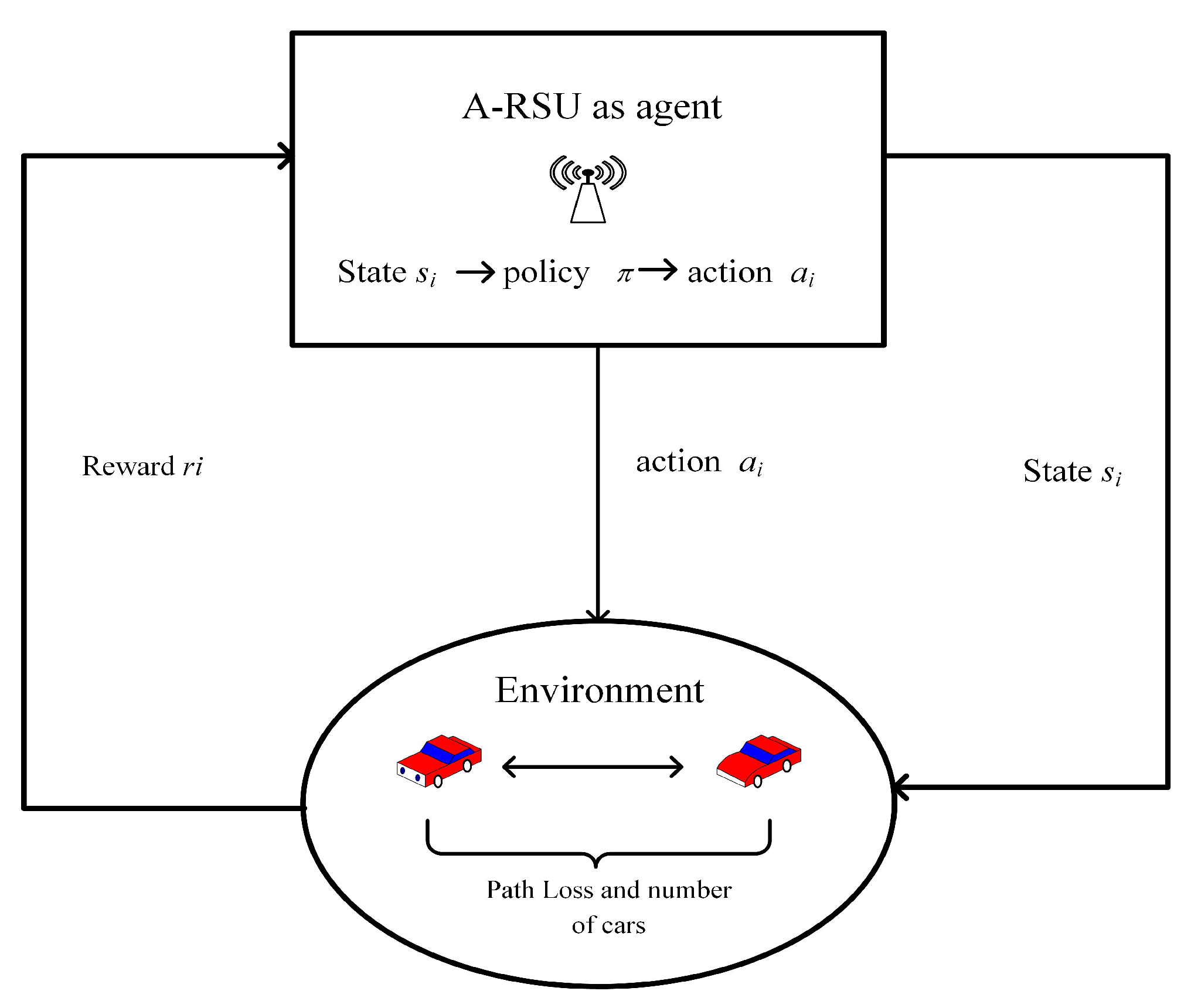
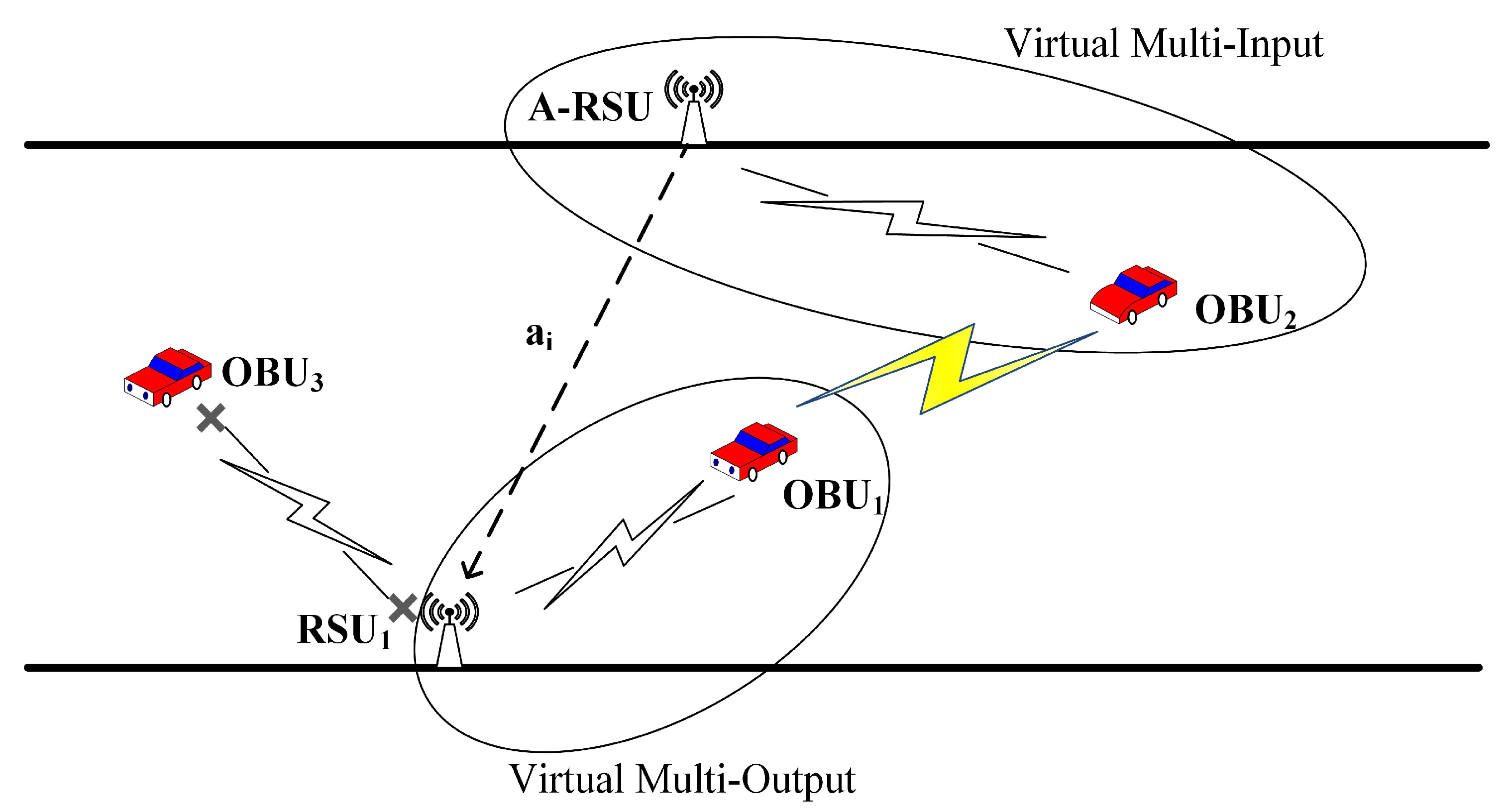
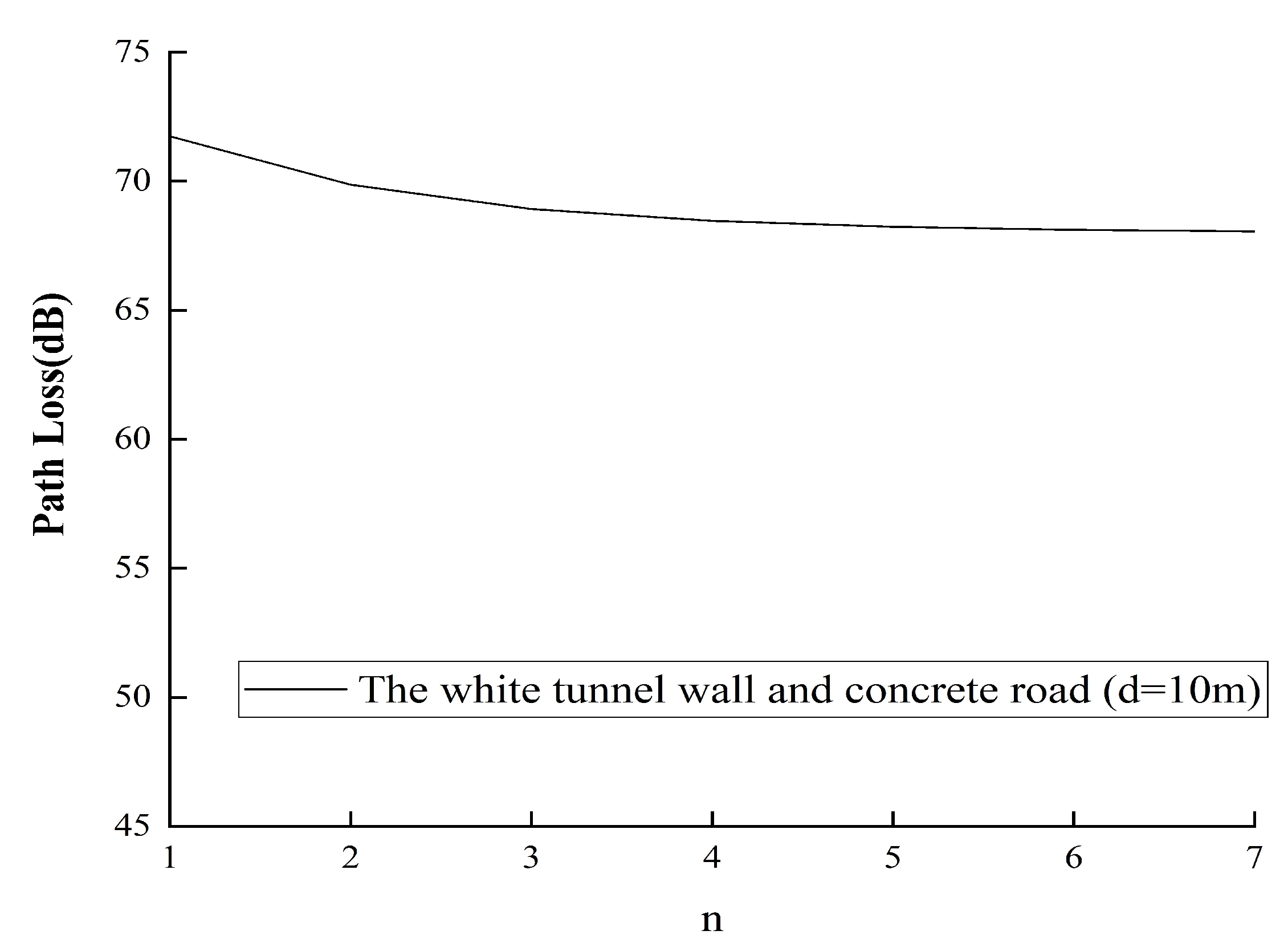

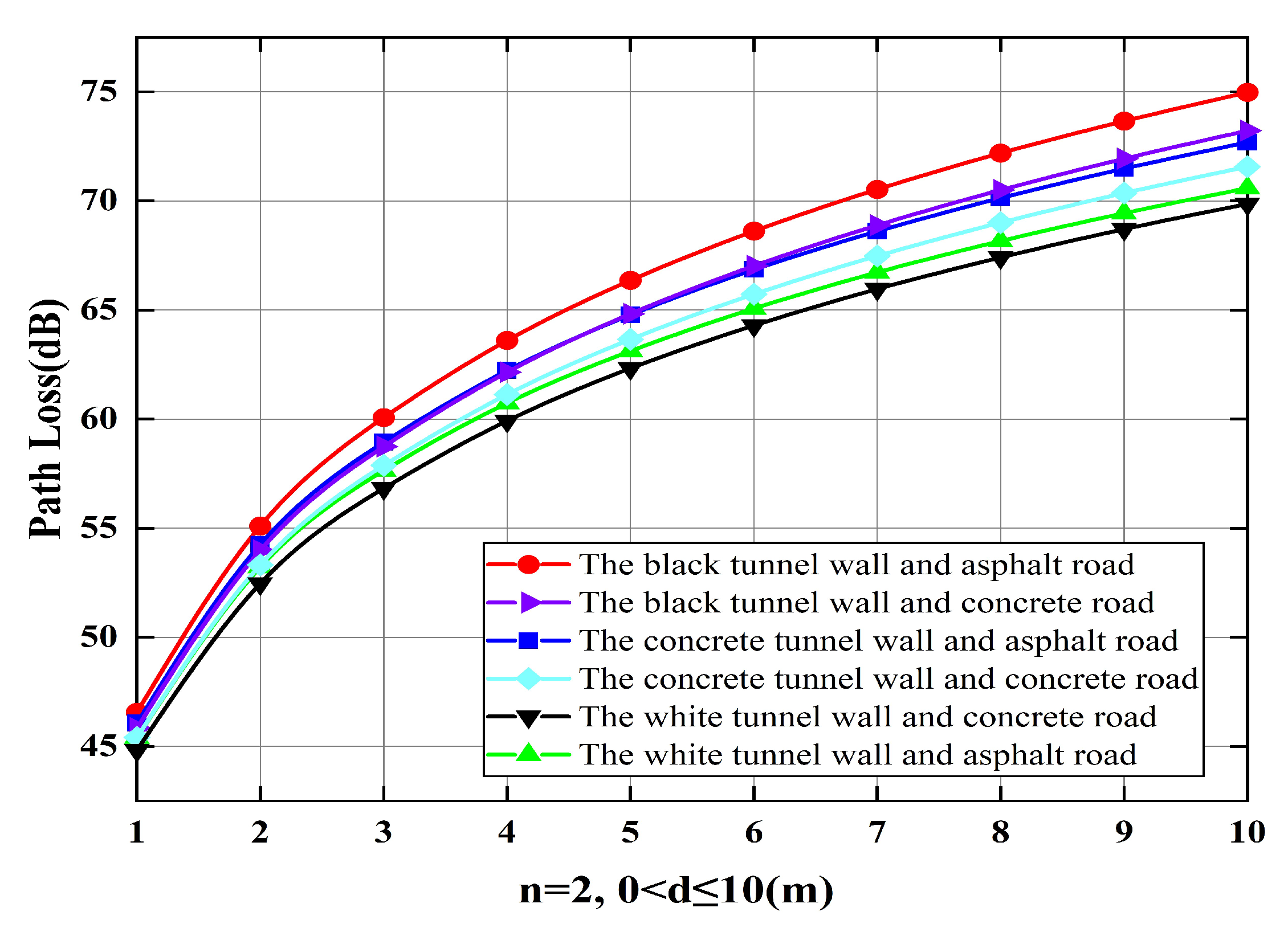
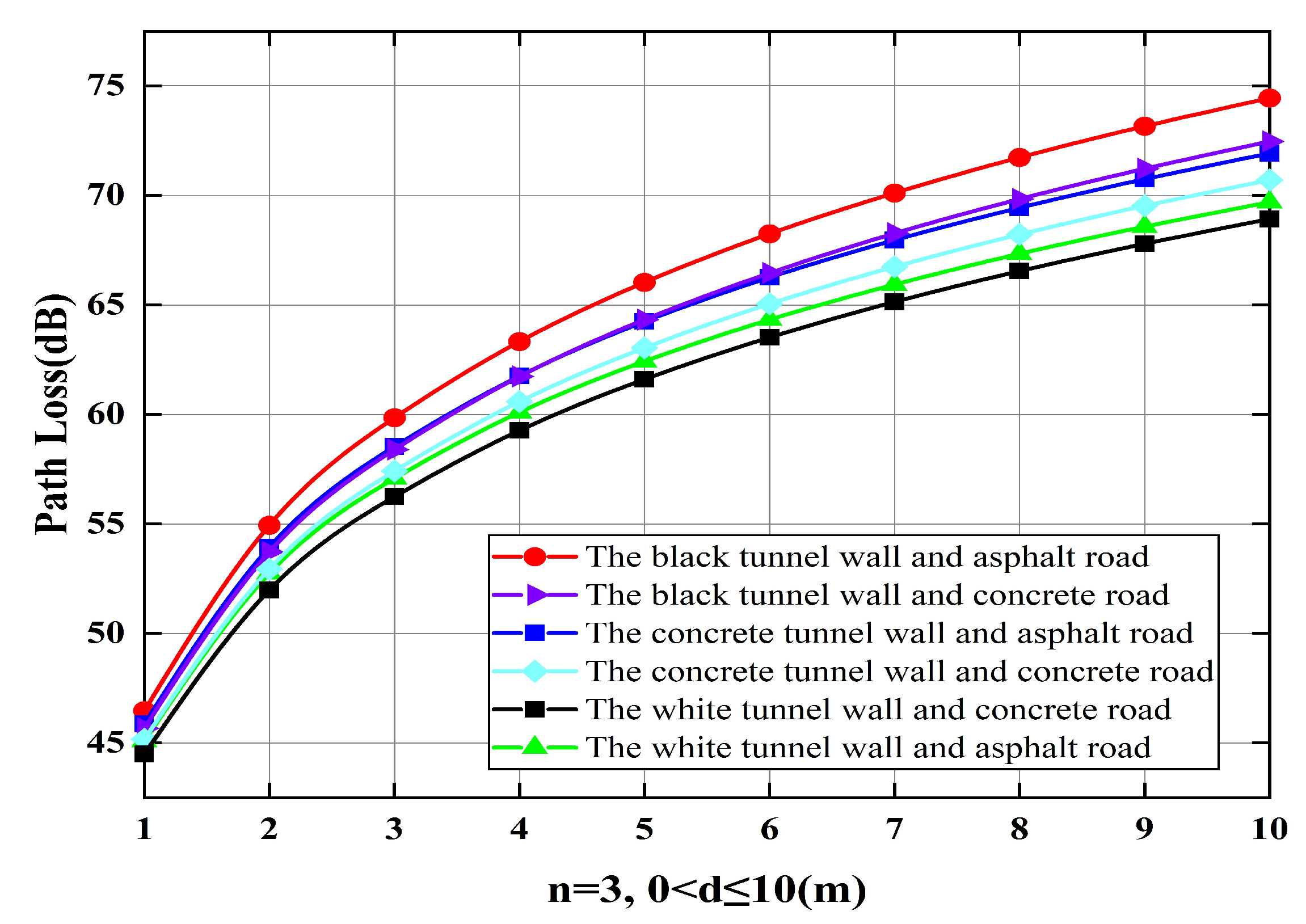
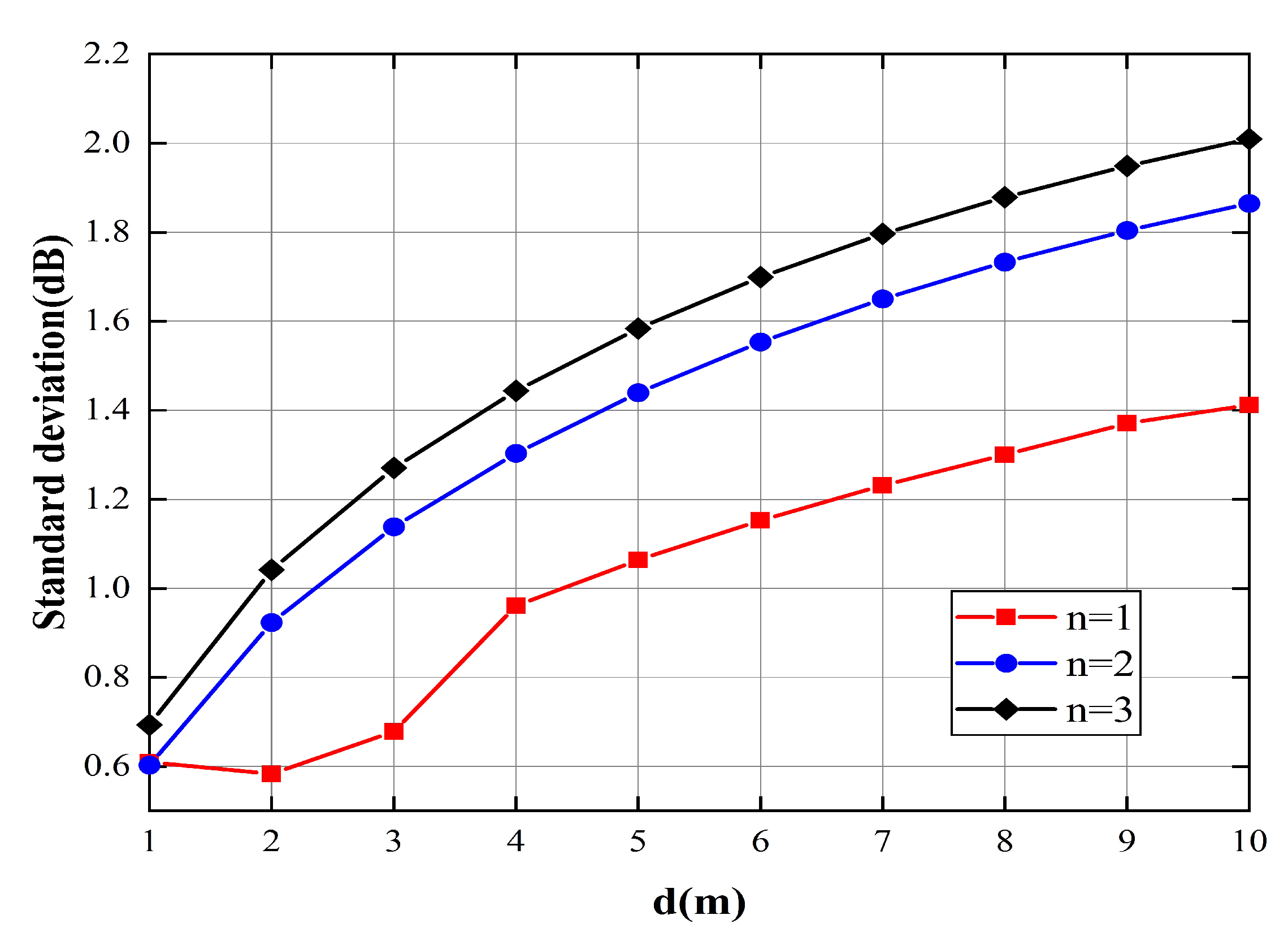

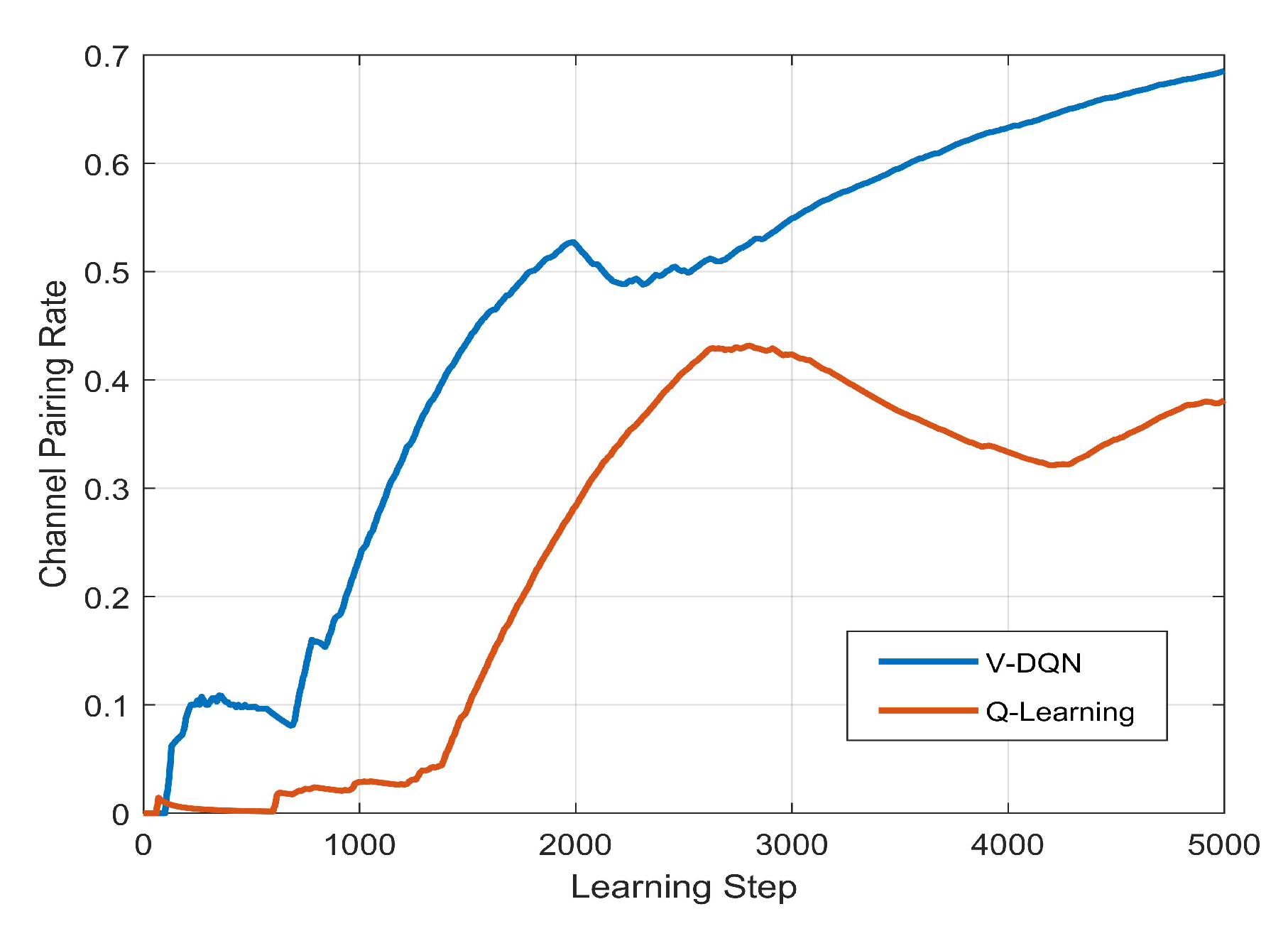

| Simulation Parameters | Parameter Value |
|---|---|
| Carrier frequency | 5.8 GHz |
| Noise power | −125 dB |
| Additional attenuation coefficient of NLOS link | 20 dB |
| Environmental parameters A, B in tunnel scene | 0.2, 12 |
| V2R transmit power | 0.5 W |
| Height of A-RSU | 6 m |
| A-RSU interference power | 1 W |
| R2R transmission power | 0.5 w |
| SNR threshold | 10 dB |
| V2R Path Loss Index | 3 |
| Learning rate | 0.01 |
| Reward discount Factor | 0.8 |
| Road type | one-way tunnel |
Disclaimer/Publisher’s Note: The statements, opinions and data contained in all publications are solely those of the individual author(s) and contributor(s) and not of MDPI and/or the editor(s). MDPI and/or the editor(s) disclaim responsibility for any injury to people or property resulting from any ideas, methods, instructions or products referred to in the content. |
© 2023 by the authors. Licensee MDPI, Basel, Switzerland. This article is an open access article distributed under the terms and conditions of the Creative Commons Attribution (CC BY) license (https://creativecommons.org/licenses/by/4.0/).
Share and Cite
Li, C.; Jin, H.; Wu, W.; Yang, M.; Wang, Q.; Pei, Y. Path Loss and Auxiliary Communication Analysis of VANET in Tunnel Environments. Symmetry 2023, 15, 1230. https://doi.org/10.3390/sym15061230
Li C, Jin H, Wu W, Yang M, Wang Q, Pei Y. Path Loss and Auxiliary Communication Analysis of VANET in Tunnel Environments. Symmetry. 2023; 15(6):1230. https://doi.org/10.3390/sym15061230
Chicago/Turabian StyleLi, Chunxiao, Honghui Jin, Wen Wu, Mei Yang, Qingyue Wang, and Yuanpeng Pei. 2023. "Path Loss and Auxiliary Communication Analysis of VANET in Tunnel Environments" Symmetry 15, no. 6: 1230. https://doi.org/10.3390/sym15061230
APA StyleLi, C., Jin, H., Wu, W., Yang, M., Wang, Q., & Pei, Y. (2023). Path Loss and Auxiliary Communication Analysis of VANET in Tunnel Environments. Symmetry, 15(6), 1230. https://doi.org/10.3390/sym15061230





